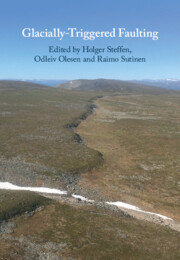Book contents
- Glacially-Triggered Faulting
- Glacially-Triggered Faulting
- Copyright page
- Contents
- Figures
- Tables
- Contributors
- Preface
- Part I Introduction
- Part II Methods and Techniques for Fault Identification and Dating
- 3 Earthquake-Induced Landforms in the Context of Ice-Sheet Loading and Unloading
- 4 The Challenge to Distinguish Soft-Sediment Deformation Structures (SSDS) Formed by Glaciotectonic, Periglacial and Seismic Processes in a Formerly Glaciated Area
- 5 Glacially Induced Fault Identification with LiDAR, Based on Examples from Finland
- 6 Fault Identification from Seismology
- 7 Imaging and Characterization of Glacially Induced Faults Using Applied Geophysics
- 8 Dating of Postglacial Faults in Fennoscandia
- 9 Proposed Drilling into Postglacial Faults
- Part III Glacially Triggered Faulting in the Fennoscandian Shield
- Part IV Glacially Triggered Faulting at the Edge and in the Periphery of the Fennoscandian Shield
- Part V Glacially Triggered Faulting Outside Europe
- Part VI Modelling of Glacially Induced Faults and Stress
- Part VII Outlook
- Index
- References
6 - Fault Identification from Seismology
from Part II - Methods and Techniques for Fault Identification and Dating
Published online by Cambridge University Press: 02 December 2021
- Glacially-Triggered Faulting
- Glacially-Triggered Faulting
- Copyright page
- Contents
- Figures
- Tables
- Contributors
- Preface
- Part I Introduction
- Part II Methods and Techniques for Fault Identification and Dating
- 3 Earthquake-Induced Landforms in the Context of Ice-Sheet Loading and Unloading
- 4 The Challenge to Distinguish Soft-Sediment Deformation Structures (SSDS) Formed by Glaciotectonic, Periglacial and Seismic Processes in a Formerly Glaciated Area
- 5 Glacially Induced Fault Identification with LiDAR, Based on Examples from Finland
- 6 Fault Identification from Seismology
- 7 Imaging and Characterization of Glacially Induced Faults Using Applied Geophysics
- 8 Dating of Postglacial Faults in Fennoscandia
- 9 Proposed Drilling into Postglacial Faults
- Part III Glacially Triggered Faulting in the Fennoscandian Shield
- Part IV Glacially Triggered Faulting at the Edge and in the Periphery of the Fennoscandian Shield
- Part V Glacially Triggered Faulting Outside Europe
- Part VI Modelling of Glacially Induced Faults and Stress
- Part VII Outlook
- Index
- References
Summary
Regions affected by glacial isostatic adjustment experience stress changes. The stress will be released either by slow aseismic movements along faults or by sudden stress release in form of earthquakes. Location and source mechanism of those earthquakes can play a major role in understanding past and ongoing geodynamic processes in a glacial isostatic adjustment-affected region. On the one hand, alignments of earthquake hypocentres may act as an indicator for active faults that might not be known from geology before. On the other hand, calculation and interpretation of earthquake focal mechanisms, represent a key to stress and stress changes. We present an overview of seismological methods and tools to retrieve fault geometry and motion.
Keywords
- Type
- Chapter
- Information
- Glacially-Triggered Faulting , pp. 100 - 117Publisher: Cambridge University PressPrint publication year: 2021



